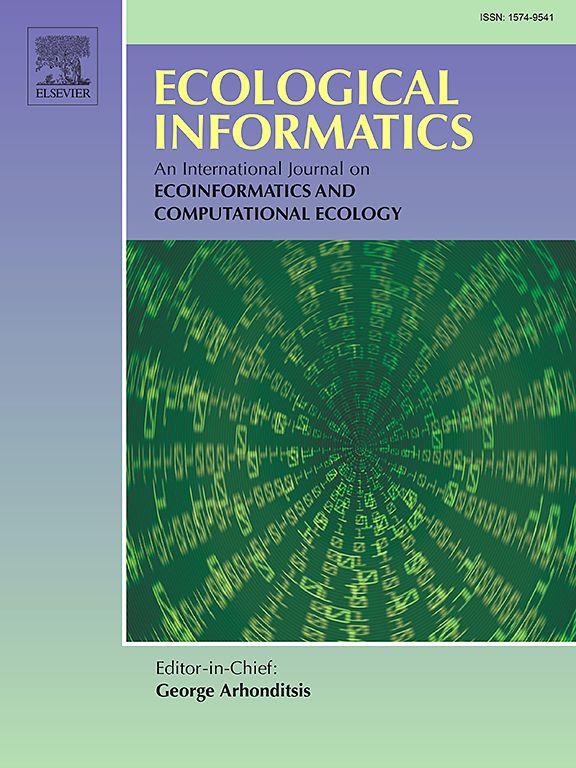城市繁华还是城市萧条?加拿大蒙特利尔养蜂的挑战、适宜性和生存见解
IF 5.8
2区 环境科学与生态学
Q1 ECOLOGY
引用次数: 0
摘要
人们对城市养蜂业的兴趣日益浓厚,这凸显了调查城市栖息地对管理蜜蜂种群是否可持续的必要性。本研究在加拿大蒙特利尔岛进行,旨在i)评估城市环境中蜂群的生存,ii)确定影响蜂群生存的主要驱动因素,以及iii)探索城市地区支持养蜂活动的潜力。本研究应用两种不同的生存分析方法,即随机森林(RSF)和生存时间Cox模型,结合静态和动态地理空间变量包括归一化植被指数(NDVI)、数字高程模型(DEM),比例的城市地区和水,植物来源多样性,道路密度,靠近公路,周围的蜂巢计数,臭氧(O₃)浓度、细颗粒物(PM2.5)水平,最高温度,和降水。为了反映典型的蜜蜂觅食范围,分析了两个缓冲距离(1 km和3 km),并使用一致性指数(C-index)和综合Brier评分(IBS)评估了模型的性能。对于1 km缓冲区,RSF模型的c指数为0.90(训练)和0.82(测试),IBS得分分别为0.06和0.10,优于Cox模型的c指数为0.56(训练和测试),IBS值分别为0.19和0.18。在3 km时,RSF进一步提高(C-index: 0.93(训练)和0.84(测试);IBS分别为0.05(训练)和0.08(检验),Cox模型C-index分别为0.58(训练)和0.60(检验);IBS: 0.19(培训)和0.18(测试))。这些结果证实了RSF的优越性能,并表明更广泛的空间背景可以提高预测精度。此外,我们的研究结果表明,在两种缓冲情况下,周围的蜂巢数量是蜂巢存活的最强预测因子。在1 km处,道路邻近度和高程(即DEM)的重要性次之,而在3 km处,高程和植被密度(即NDVI)的影响更大。本研究的一个主要结果是为蒙特利尔生成空间明确的蜂巢生境适宜性地图。这些地图显示,2017-2021年的平均值显示,该岛的大部分地区都有利于城市养蜂,30.94%的土地被列为高度适宜,38.28%的土地被列为中等适宜,显示出在城市环境中可持续养蜂的强大潜力。该研究有助于通过适宜性映射和预测分析为城市规划和管理蜜蜂保护提供见解。本文章由计算机程序翻译,如有差异,请以英文原文为准。
Urban buzz or urban bust? Beekeeping challenges, suitability, and survival insights in Montreal, Canada
The rising interest in urban beekeeping underscores the need to investigate whether urban habitats are sustainable for managed honeybee populations. This study, conducted on the island of Montreal, Canada, aimed to i) assess honeybee colony survival within an urban environment, ii) determine the primary drivers affecting honeybee colony survival, and iii) explore the potential of urban areas to support beekeeping activities. This study applied two distinct survival analysis methods, namely random survival forests (RSF) and time-dependent Cox models, incorporating both static and dynamic geospatial variables including normalized difference vegetation index (NDVI), digital elevation model (DEM), percentages of urban areas and water, floral source diversity, road density, proximity to roads, surrounding hive count, ozone (O₃) concentration, fine particulate matter (PM2.5) levels, maximum temperature, and precipitation. To reflect typical honeybee foraging ranges, two buffer distances (1 km and 3 km) were analyzed, and model performance was assessed using the concordance index (C-index) and integrated Brier score (IBS). For the 1 km buffer, the RSF model achieved a C-index of 0.90 (training) and 0.82 (test) with IBS scores of 0.06 and 0.10, outperforming the Cox model, which showed a C-index of 0.56 (both training and test) and IBS values of 0.19 and 0.18. At 3 km, RSF further improved (C-index: 0.93 (training) and 0.84 (test); IBS: 0.05 (training) and 0.08 (test)), while the Cox model remained lower (C-index: 0.58 (training) and 0.60 (test); IBS: 0.19 (training) and 0.18 (test)). These results confirm RSF's superior performance and suggest that broader spatial context may enhance prediction accuracy. Additionally, our findings revealed that the surrounding hive count was the strongest predictor of beehive survival in both buffer scenarios. At 1 km, road proximity and elevation (i.e., DEM) followed in importance, while at 3 km, elevation and vegetation density (i.e., NDVI) were more influential. A primary outcome of this study was the generation of spatially explicit beehive habitat suitability maps for Montreal. Averaged over 2017–2021, these maps showed that large portions of the island are favorable for urban beekeeping, with 30.94 % of land classified as highly suitable and 38.28 % as moderately suitable, demonstrating strong potential for sustainable apiculture in urban environments. This study contributes to providing insights into urban planning and managed honeybee conservation through suitability mapping and predictor analysis.
求助全文
通过发布文献求助,成功后即可免费获取论文全文。
去求助
来源期刊

Ecological Informatics
环境科学-生态学
CiteScore
8.30
自引率
11.80%
发文量
346
审稿时长
46 days
期刊介绍:
The journal Ecological Informatics is devoted to the publication of high quality, peer-reviewed articles on all aspects of computational ecology, data science and biogeography. The scope of the journal takes into account the data-intensive nature of ecology, the growing capacity of information technology to access, harness and leverage complex data as well as the critical need for informing sustainable management in view of global environmental and climate change.
The nature of the journal is interdisciplinary at the crossover between ecology and informatics. It focuses on novel concepts and techniques for image- and genome-based monitoring and interpretation, sensor- and multimedia-based data acquisition, internet-based data archiving and sharing, data assimilation, modelling and prediction of ecological data.
 求助内容:
求助内容: 应助结果提醒方式:
应助结果提醒方式:


